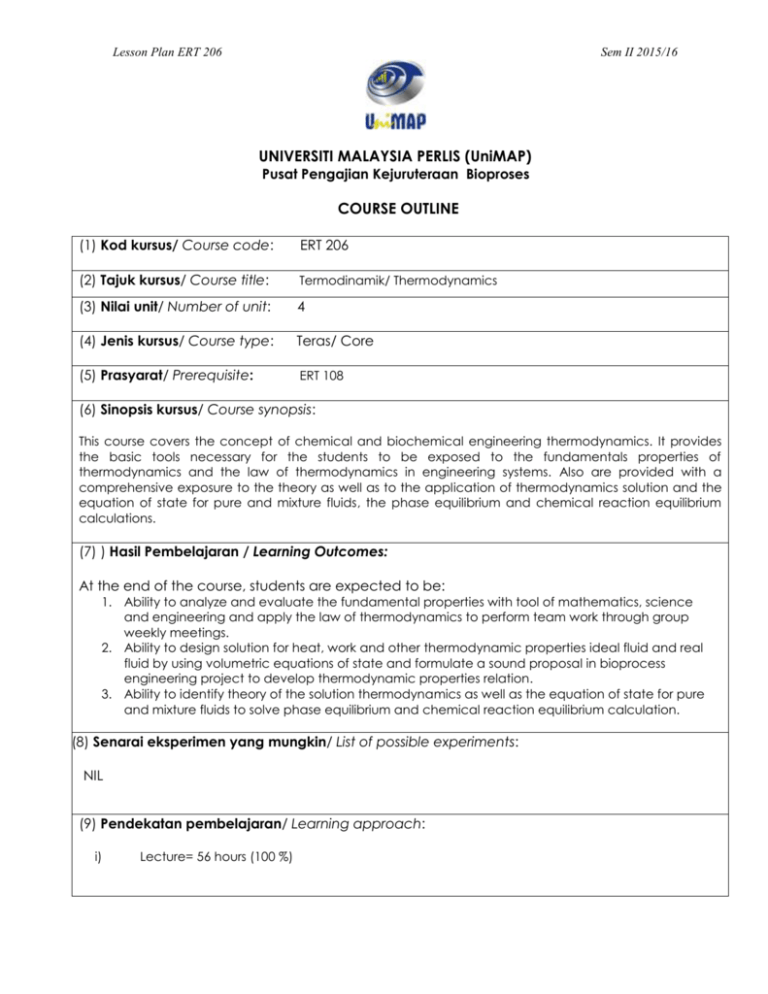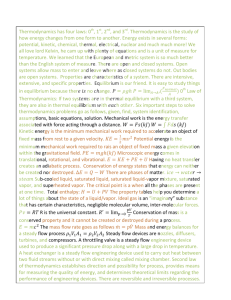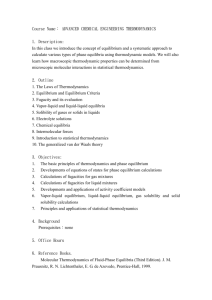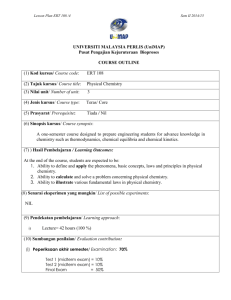
Lesson Plan ERT 206
Sem II 2015/16
UNIVERSITI MALAYSIA PERLIS (UniMAP)
Pusat Pengajian Kejuruteraan Bioproses
COURSE OUTLINE
(1) Kod kursus/ Course code:
ERT 206
(2) Tajuk kursus/ Course title:
Termodinamik/ Thermodynamics
(3) Nilai unit/ Number of unit:
4
(4) Jenis kursus/ Course type:
Teras/ Core
(5) Prasyarat/ Prerequisite:
ERT 108
(6) Sinopsis kursus/ Course synopsis:
This course covers the concept of chemical and biochemical engineering thermodynamics. It provides
the basic tools necessary for the students to be exposed to the fundamentals properties of
thermodynamics and the law of thermodynamics in engineering systems. Also are provided with a
comprehensive exposure to the theory as well as to the application of thermodynamics solution and the
equation of state for pure and mixture fluids, the phase equilibrium and chemical reaction equilibrium
calculations.
(7) ) Hasil Pembelajaran / Learning Outcomes:
At the end of the course, students are expected to be:
1. Ability to analyze and evaluate the fundamental properties with tool of mathematics, science
and engineering and apply the law of thermodynamics to perform team work through group
weekly meetings.
2. Ability to design solution for heat, work and other thermodynamic properties ideal fluid and real
fluid by using volumetric equations of state and formulate a sound proposal in bioprocess
engineering project to develop thermodynamic properties relation.
3. Ability to identify theory of the solution thermodynamics as well as the equation of state for pure
and mixture fluids to solve phase equilibrium and chemical reaction equilibrium calculation.
(8) Senarai eksperimen yang mungkin/ List of possible experiments:
NIL
(9) Pendekatan pembelajaran/ Learning approach:
i)
Lecture= 56 hours (100 %)
Lesson Plan ERT 206
Sem II 2015/16
(10) Sumbangan penilaian/ Evaluation contribution:
(i) Peperiksaan/ Examination: 70%
Midterm Examinations = 20%
Final Examination
= 50%
(ii) Penilaian Berterusan/Continual Assessment: 30%
Assignments /Quizzes
Integrated project
= 15%
= 15%
(11) Pensyarah /Lecturers
i.
ii.
iii.
Miss Hanna Ilyani Zulhaimi (C)
Dr Midhat Nabil Bin Ahmad Salimi
Sir Ir. Fadhli
(12) Senarai buku teks dan rujukan/ List of text books and references : (Dahulukan dengan
rujukan yang utama/ list main texts/references first)
Buku Teks:
i)
ii)
iii)
iv)
v)
Cengel, Y.A. and Boles, M.A., Thermodynamics-An engineering Approach, 7th edition, McGraw-Hill,
2010.
Smith, J.M., Van Ness, H.C. and Abbort, M.M., introduction to Chemical Engineering Thermodynamics,
Seventh Edition, McGraw-Hill, 2005.
Narayanan, K.V. A Text Book of Chemical Engineering Thermodynamics, Prentice-Hall India, 2010.
K. Iynkaran, J. David and Tandy, Basic Thermodynamics – Applications and Pollution Control, 2nd
edition, Pearson Prentice Hall, 2004.
Stanley I. Sandler, Chemical, biochemical, and engineering thermodynamics, Volume 1, 4th edition,
John Wiley & Sons, 2006.
Lesson Plan ERT 206
Sem II 2015/16
RANCANGAN MENGAJAR/LESSON PLAN
StudyWeek
Week 1
(15 Feb – 19 Feb)
Kandungan Kursus / Course Contents
Pensyarah/Lecture
(Panduan/Guidelines)
r
Introduction to Thermodynamics
Miss Hanna Ilyani
Unique vocabulary and scope, dimensions and units,
Zulhaimi
measure of amount or size, force, temperature,
pressure, work, energy and heat
(4 hours)
Week 2
(22 Feb – 25 Feb)
General energy analysis and The first law of
thermodynamics
Forms of energy, the nature of internal energy, energy
transfer by heat, First law of thermodynamics, energy
balances and mechanisms of energy transfer.
(4 hours)
Miss Hanna Ilyani
Zulhaimi
Week 3-4
(29 March – 11 March)
Volumetric properties of pure fluids
Pure substances, phase-change processes, P-v, T-v, P-v
property diagrams and P-v-T surfaces of pure
substances, property tables, the ideal-gas equation of
state, compressibility factor and other equations of
state.
(8 hours)
Miss Hanna Ilyani
Zulhaimi
Week 5
(14 March – 18 March)
Mass and Energy Analysis
Moving boundary work, energy balance for closed
systems, specific heat at constant volume and pressure,
internal energy, enthalpy and specific heats of ideal
gases and incompressible substances, mass and energy
balances for steady- and unsteady-flow processes.
(4 hours)
Miss Hanna Ilyani
Zulhaimi
Week 6
(21 March – 25 March)
Second law of thermodynamics
Second law of thermodynamics, thermal energy
reservoirs, heat engines, refrigerators and heat pumps,
Kelvin-Planck and Clausius statements, reversible and
irreversible processes, thermodynamics temperature
scale.
(4 hours)
Dr Midhat Nabil
Bin Ahmad Salimi
Week 7
28 March – 1 Apr
Entropy
Entropy, some remark about entropy, entropy changes
Dr Midhat Nabil
Bin Ahmad Salimi
Lesson Plan ERT 206
Sem II 2015/16
of pure substances, incompressible substances and
ideal gases, isentropic processes, reversible steady-flow
work relations and the entropy balance to various
systems.
(4 hours)
Week 8
(4 Apr – 8 Apr)
Refrigeration Cycles
Refrigerators and heat pumps, ideal vapor-compression
refrigeration cycle and the actual vapor-compression
refrigeration cycle, selecting the right refrigerant, heat
pump systems, gas refrigeration systems and
absorption-refrigeration systems.
(4 hours)
Dr Midhat Nabil
Bin Ahmad Salimi
Week 9
(11 Apr – 17 Apr)
SEMESTER BREAK
Week 10
(18 Apr – 22 Apr)
Thermodynamics property relations
Partial derivatives and associated relations, Maxwell
relation, Clapeyron equation and enthalpy of
vaporization, general relation of Cv, Cp, du, dh and ds,
the ∆h, ∆u, and ∆s of real gases (enthalpy, internal
energy and entropy changes of real gases).
(4
hours)
Dr Midhat Nabil
Bin Ahmad Salimi
Week 11
(25 Apr – 29 May)
Vapor/ Liquid Equilibrium: Introduction
The nature of equilibrium, the phase rule. Duhem’s
Theorem, VLE: Qualitative behavior, simple models for
vapor/liquid equilibrium, VLE by modified Roult’s Law
and VLE from K-Value correlations.
(4 hours)
Ir Fadhli
Week 12-13
(2 May – 13 May)
Solution Thermodynamics: Theory and Applications
Fundamental property relation, the chemical potential
and phase equilibrium, partial properties, the ideal-gas
mixture model, fugacity and fugacity coefficient; Pure
species and species in solution, generalized correlations
for the fugacity coefficient, the ideal-solution model,
excess properties, liquid-phase properties from VLE
data, models for the excess Gibbs energy, property
changes in mixing and heat effects of mixing processes.
(8 hours)
Ir Fadhli
Lesson Plan ERT 206
Week 14-15
(16 May – 27 May)
Week 16
(30 June – 5 June)
Week 17-18
(27 June – 4 September)
Sem II 2015/16
Chemical-Reaction Equilibrium
The reaction coordinate, application of equilibrium
criteria to chemical reactions, the standard Gibbsenergy change and equilibrium constant, effect of
temperature on the equilibrium constant, evaluation of
equilibrium constants, relation of equilibrium constants
to composition, equilibrium conversions for single
reactions, phase rule and Duhem’s Theorem for
reacting systemsand multireaction equilibrium.
(8 hours)
Ir Fadhli
MINGGU ULANGKAJI / REVISION WEEK
PEPERIKSAAN AKHIR SEMESTER / FINAL EXAMINATION







